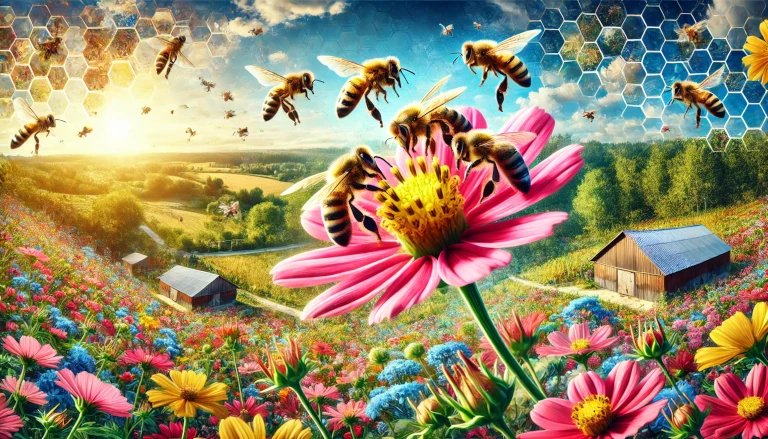Honey production is a fascinating process that involves bees collecting nectar, processing it within their hives, and transforming it into the golden, sweet substance we know and love. Honey is not only a delicious natural sweetener but also packed with antioxidants and nutrients that offer various health benefits. With growing interest in natural products and sustainable practices, understanding how honey is produced can help us appreciate the role of bees in our ecosystem and the effort involved in bringing honey to our tables.
In this blog post, we’ll take a look at how honey is made, the stages of honey production, the different types of honey, and the benefits it offers. Whether you’re a honey lover or curious about the beekeeping process, this guide will give you a clear understanding of honey production from start to finish.
The Process of Honey Production 🐝🍃
Honey production involves a series of steps that start with bees collecting nectar from flowers and ends with honey being stored in honeycombs within the hive. Here’s how the process works:
1. Nectar Collection 🌸🐝
The process begins when worker bees collect nectar from flowering plants. Using their long, tube-like tongues, bees gather nectar and store it in their honey stomachs, which is a separate compartment from their digestive stomachs.
2. Nectar Processing 🐝🔄
Once a bee’s honey stomach is full, it returns to the hive and transfers the nectar to other worker bees. These bees chew the nectar, breaking down its complex sugars into simpler ones, which makes it easier to digest. This process also reduces the water content in the nectar.
3. Evaporation and Storage 🍯🧺
After processing, the nectar is placed into honeycomb cells within the hive. Bees then fan their wings to create airflow and speed up the evaporation process, reducing the water content even further and transforming the nectar into honey. When the honey is ready, bees seal the honeycomb cells with beeswax to preserve it.
4. Harvesting the Honey 🧺🚜
Beekeepers harvest the honey by carefully removing the honeycombs from the hive. They use special tools to unseal the beeswax caps, extract the honey, and filter it to remove any impurities. Once filtered, the honey is ready to be bottled and enjoyed.
Different Types of Honey 🍯🌸
Honey comes in various types, each with its own unique flavor and color, depending on the flowers from which the nectar is collected. Here are some common types:
- Clover Honey: Light in color and mild in flavor, clover honey is one of the most popular types available.
- Manuka Honey: Sourced from the Manuka tree in New Zealand, this honey is known for its strong flavor and antibacterial properties.
- Wildflower Honey: Made from the nectar of various wildflowers, this honey has a rich, complex taste that varies depending on the flowers in bloom.
- Acacia Honey: Pale yellow and sweet, acacia honey remains liquid for a long time and is valued for its mild flavor.
Benefits of Honey 🐝💧
Honey is more than just a natural sweetener; it’s also packed with health benefits:
1. Rich in Antioxidants 🍏💚
Honey contains antioxidants that help protect the body from damage caused by free radicals. These compounds can reduce the risk of heart disease, cancer, and other chronic illnesses.
2. Natural Antibacterial Properties 💊🍯
Certain types of honey, like Manuka honey, have antibacterial properties that can help treat wounds and prevent infections. Honey can also soothe sore throats and help alleviate cold symptoms.
3. Boosts Energy 🌞🏃♀️
Honey is a natural source of carbohydrates, making it a quick and effective energy booster. Many athletes and fitness enthusiasts use honey as a natural pre- or post-workout fuel.
4. Supports Digestive Health 🌾🍃
Raw honey contains enzymes that aid digestion and can help soothe digestive issues like acid reflux and indigestion. It also has prebiotic properties that promote a healthy gut microbiome.
How Honey Production Supports the Environment 🌍💚
Honey production is essential not only for honey but also for supporting ecosystems through pollination. Bees are crucial pollinators, responsible for the growth of many fruits, vegetables, and flowers. By supporting honey production, we indirectly contribute to the health of our food systems and the overall biodiversity of the planet.
Real-Life Example: Sustainable Honey Production in India 🇮🇳🐝
In India, honey production is not only a thriving industry but also a sustainable practice that supports rural livelihoods. Local beekeepers often use traditional methods to harvest honey, which helps preserve the natural habitat of bees and promotes environmental sustainability. Organizations like the Khadi and Village Industries Commission (KVIC) support beekeepers by providing training and resources, ensuring that honey production remains eco-friendly and economically beneficial for rural communities.
Tips for Buying High-Quality Honey 🛒🍯
If you’re looking to purchase honey, here are some tips to ensure you’re getting the best quality:
- Look for Raw Honey: Raw honey is unprocessed and retains more of its natural enzymes, antioxidants, and nutrients compared to processed honey.
- Check the Label: Choose honey labeled as organic or wildflower to ensure it’s free from additives and sourced from diverse floral sources.
- Buy Local Honey: Supporting local beekeepers not only ensures you’re getting fresh honey but also helps sustain local bee populations and promotes biodiversity.
Honey Production – A Sweet Process with Big Benefits 🍯💛
Honey production is a remarkable process that showcases the hard work of bees and the importance of sustainable practices. From the collection of nectar to the extraction of honey, every step contributes to producing a natural, nutritious sweetener that offers a range of health benefits. By choosing honey, you support beekeepers, promote pollination, and contribute to environmental conservation.
Next time you enjoy a spoonful of honey, remember the incredible journey it took from bees to bottles. Supporting honey production means celebrating the essential role of bees in our ecosystem and appreciating the sweet gifts of nature.
Discover more from Green Ecosystem - Renewable Energy, Agriculture, and Environmental Sustainability
Subscribe to get the latest posts sent to your email.


